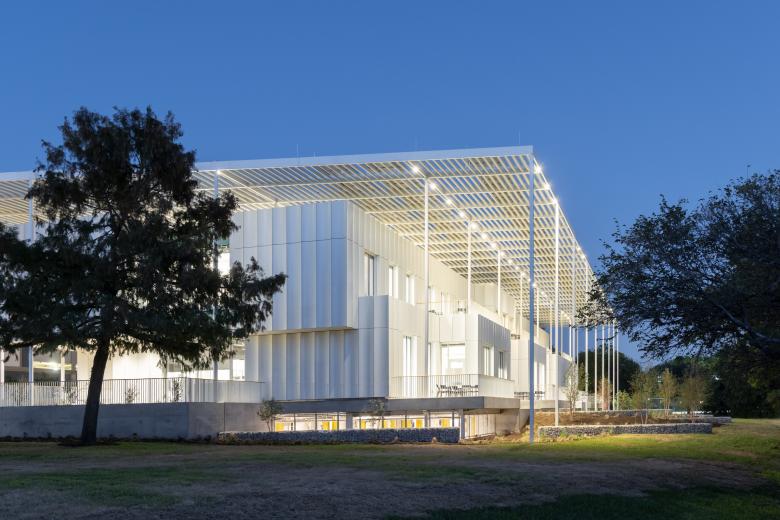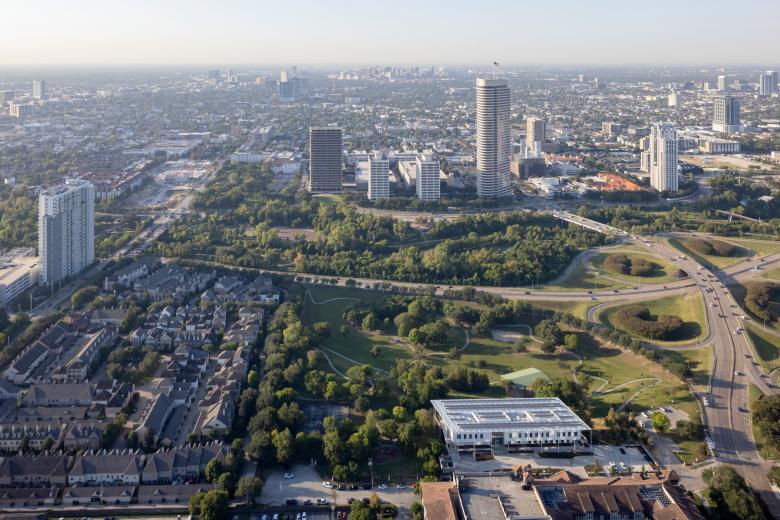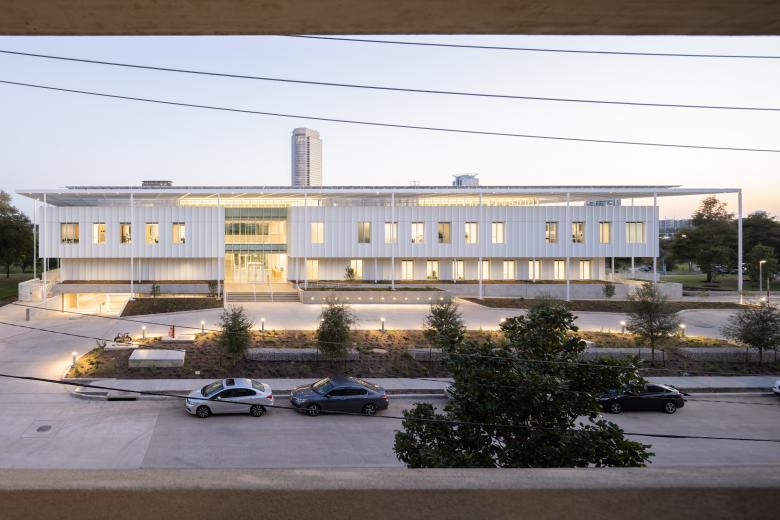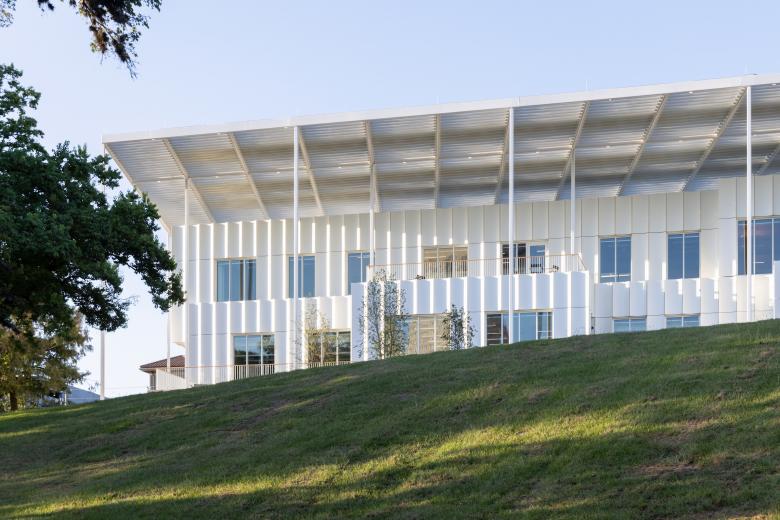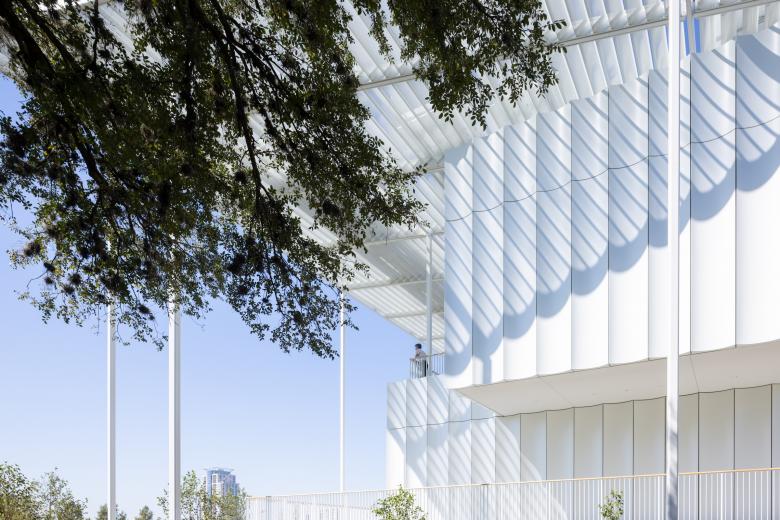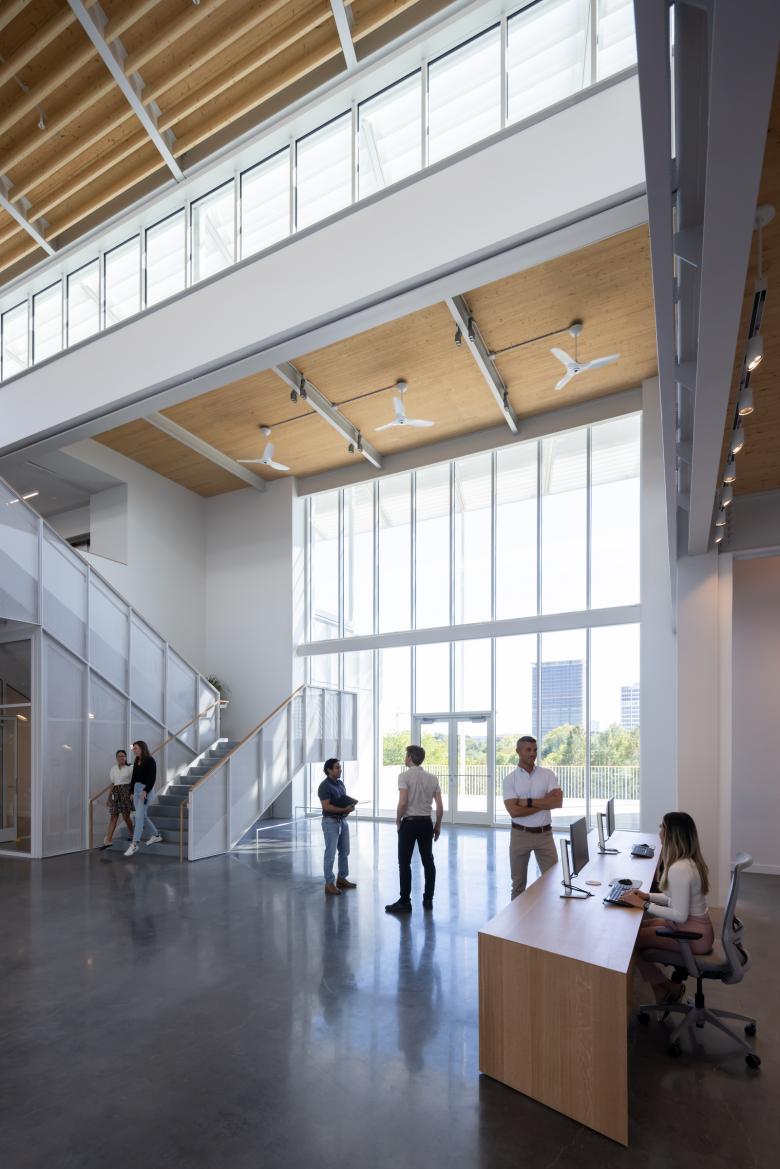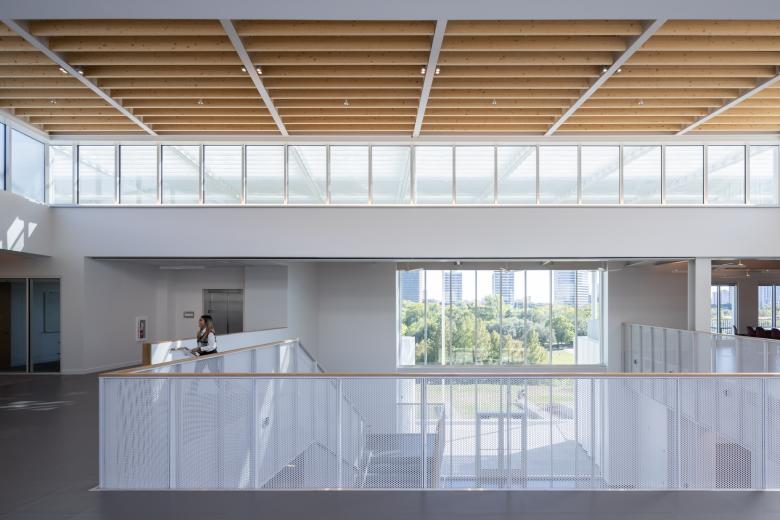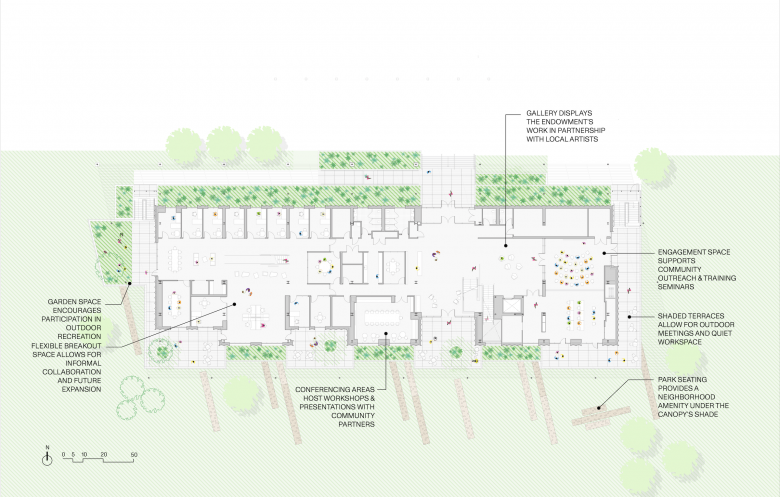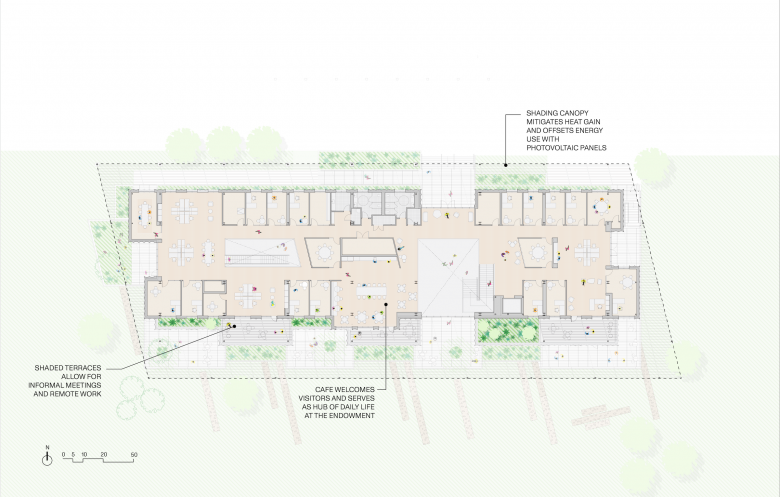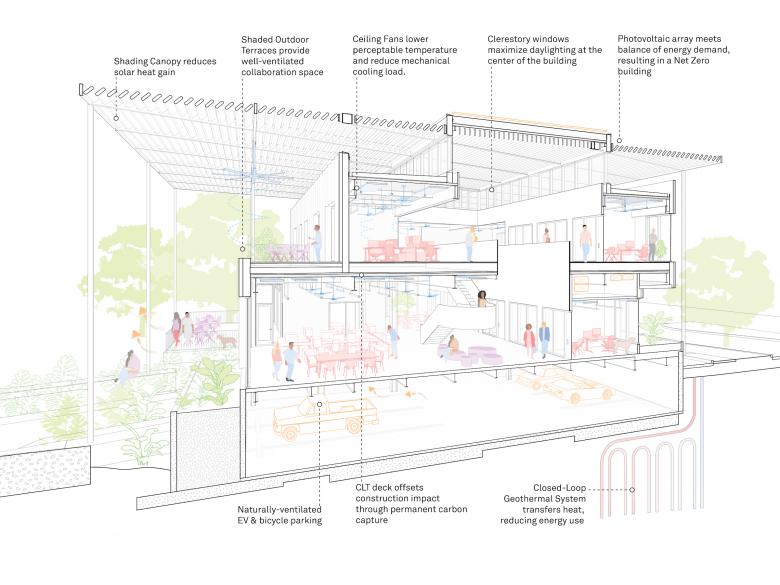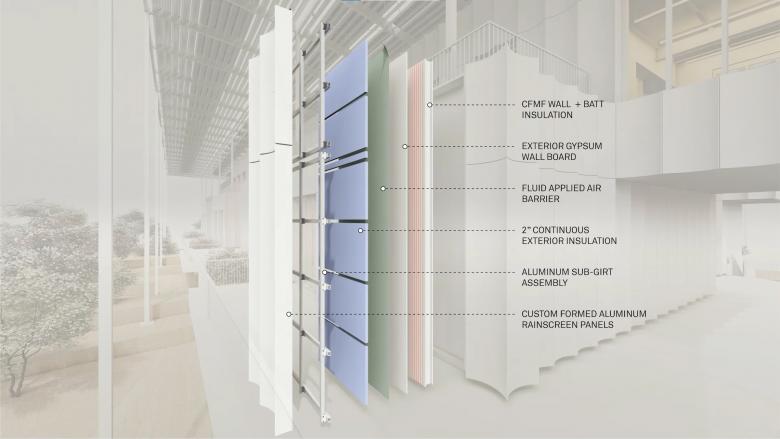US Building of the Week
Houston Endowment Headquarters
Kevin Daly Architects, PRODUCTORA
27. March 2023
Houston Endowment Headquarters, southwest view (Photo: Iwan Baan, courtesy of Kevin Daly Architects)
The new headquarters for Houston Endowment is located west of Downtown Houston in Spotts Park, on the banks of the city's Buffalo Bayou. Designed by Kevin Daly Architects (kdA) in collaboration with PRODUCTORA, the building was dedicated on October 11, 2022. The architects at kdA answered a few questions about the building.
Location: Houston, Texas, USA
Client: Houston Endowment
Architect: Kevin Daly Architects, with collaborating architect PRODUCTORA
- Design Principal: Kevin Daly, FAIA (kdA)
- Collaborating Principal: Wonne Ickx (PRODUCTORA)
- Project Manager: Luke Smith (kdA)
- Project Architect: Gretchen Stoecker (kdA)
- Project Team (kdA): Phineas Taylor-Webb, Ryan Conroy, Casey Worrell, Kevin Ulmer, Evan Hursley, Robert Becker
- Project Team (PRODUCTORA): Nicolás Fueyo
MEP/FP Engineer: CMTA
Landscape Architect: Tom Leader Studio
Lighting Designer: George Sexton Associates
Contractor: WS Bellows
Construction Manager: Forney Partnership
Civil Engineer: BGE
Sustainability: Transsolar
AV/IT: 4B Technology
Acoustics: Newson Brown
Waterproofing: CDC
Environmental Graphics: MG&Co
Building Area: 31,718 sf
See bottom for Important Manufacturers / Products.
Houston Endowment Headquarters, aerial view (Photo: Iwan Baan, courtesy of Kevin Daly Architects)
What were the circumstances of receiving the commission for this project?Through a 2019 international design competition conducted by the Houston Endowment and competition organizers Malcom Reading Consultants, Kevin Daly Architects (kdA) in collaboration with Mexico City-based PRODUCTURA were selected to design the private foundation’s new home, the Houston Endowment Headquarters.
The design competition committee unanimously selected Kevin Daly Architects with PRODUCTURA from among 120 designs submitted in the two-stage competition, securing the $20 million project’s commission with its ambitious goal of opening in 2022.
Houston Endowment Headquarters, north facade (Photo: Iwan Baan, courtesy of Kevin Daly Architects)
Please provide an overview of the project.The Headquarters enables Houston Endowment, one of the largest private foundations in Texas, to relocate from its former offices in the city’s business district and embed itself within the community. The purpose-built headquarters creates a more accessible, welcoming base of operations where their work can continue to evolve and transform into the future.
The winning design envisages an airy, elegant superstructure generously shaded by a large canopy within a grove of oak trees. The design is strongly connected to the site and context: the landscape and history of Spotts Park on the banks of Houston’s Buffalo Bayou. The new building, which is attuned to Houston’s demanding climate, is intended to be as welcoming as the shadow beneath a tree.
Houston Endowment Headquarters, south facade (Photo: Iwan Baan, courtesy of Kevin Daly Architects)
The intricate lattice of the sculptural roof canopy offers a sense of shelter to both the organization and the local community, encouraging the use of outdoor terraces, maximizing use of daylight within the building, and minimizing solar gain.
Interior spaces are conceived within public and private zones and are highly flexible, linked to the park through a series of exterior terraces, shaded by the canopy. The design promotes healthy working and offers welcoming engagement spaces that provide zones for convening and collaborating with the community. The dynamic setting of the new Headquarters allows the Houston Endowment unprecedented engagement with individuals from the public, private, non-profit, and philanthropic sectors.
Houston Endowment Headquarters, east facade (Photo: Iwan Baan, courtesy of Kevin Daly Architects)
What are the main ideas and inspirations influencing the design of the building?The challenge of the project was to create a building that is simultaneously a front door and a back porch for the organization. The front door is the public representation of the Endowment, formal enough to greet institutional partners while remaining approachable for any member of the community to feel welcome, with a strong sense of belonging for collaborators and first-time visitors alike.
We recognized that the building for the Endowment would be a representation of the city of Houston, its complex social structure, its relation to the environment and the changes to the environment that the city faces.
The Endowment’s brief challenged our team, through a collaboration, to represent the work of the Endowment, which provides a network of support to the organizations in Houston, to fully engage the landscape and complement Spotts Park, and to develop a robust environmental strategy that could be a roadmap for other organizations in the city.
Houston Endowment Headquarters, lobby (Photo: Iwan Baan, courtesy of Kevin Daly Architects)
The building’s design team was also inspired by one of Houston’s most characteristic features: the landscape of trees that Swedish architect and Rice University architecture professor and former dean Lars Lerup named the “zoohemic” canopy. Whether seen from a downtown tower or from under the lines of oaks on the Rice campus, building in Houston meant engaging the filtered light and cool shade of the tree canopy.
Houston has impressive antecedents of austere, refined buildings in verdant settings that are gracious and welcoming to the public: the recently opened expansion at the Museum of Fine Arts, Houston, the Brochstein Pavilion at Rice University, and the buildings that make up the Menil Collection. We were fortunate to have this history of only-in-Houston buildings as guidelines as we worked to create a new headquarters for the Houston Endowment.
Houston Endowment Headquarters, lobby from the second floor (Photo: Iwan Baan, courtesy of Kevin Daly Architects)
How does the design respond to the unique qualities of the site?The brief for the new Houston Endowment headquarters challenged us to consider how to engage a private philanthropic organization with a public mission to create, for the first time, a highly visible home for the organization within a park-like setting while interweaving imperatives of public and private at multiple levels. The Endowment sought a building that welcomes its constituents and the partner organizations that it supports while remaining a private entity. The headquarters is set on the edge of the public Spotts Park, borrowing its openness and engaging the landscape to create a visible representation of both the institution and the Houston community it serves.
Ground floor plan
Was the project influenced by any trends in energy-conservation, construction, or design?The 2030 Net Zero Challenge was set as the project’s primary sustainability objective, providing an achievable and forward-thinking framework in setting a goal of carbon neutrality by 2030 through prioritizing energy-efficient planning and design. The 2030 challenge is a scheme for construction projects, with the ultimate goal of creating carbon-neutral buildings by the year 2030. By including a geothermal well system, high efficiency rainscreen facade, and shade canopy, the carbon consumption of Houston Endowment headquarters will be reduced by 33%, as compared to a typical office building. The energy generation from the photovoltaic system will cover the balance of the required energy demand, therefore resulting in a “net zero” project.
Upper level plan
What products or materials have contributed to the success of the completed building?A hybrid structural system composed of steel framing and cross-laminated-timber provides the building with a flexible and efficient framework with which to freely organize the interior. Cross-laminated timber (CLT) is a large-scale, prefabricated, solid engineered wood panel. Lightweight yet very strong, with superior acoustic, fire, seismic and thermal performance, CLT is also fast and easy to install, generating almost no waste onsite. CLT offers design flexibility and low environmental impacts. For these reasons, CLT has proven to be an advantageous alternative to conventional systems like concrete, masonry or steel framing, especially in multifamily and commercial construction.
Section perspective
Engaging Transsolar, the environmental engineering consultant for the project, was essential in establishing the energy performance we should expect from a new building and the assumptions we can rely on as designers in an increasingly extreme environment. The building glazing is shaded by a canopy that nearly fills the site while filtered daylight is harvested from all sides. The canopy limits heat gain while producing the electricity the building consumes.
Developing the exterior with fabricator Kinetica, based in Monterrey, Mexico, resulted in the custom-formed, scalloped aluminum rainscreen. The lightness of the cladding, both in materiality and in color, emerged as a critical feature of the building’s performance in the Houston climate, reducing the latent heat of the building’s exterior and minimizing the energy demand of cooling the building.
Email interview conducted by John Hill.
Facade diagram
Important Manufacturers / Products:- Structure: Myrex (steel), Nordic (CLT)
- Rainscreen and Aluminum Louvers: Kinetica
- EIFS: Parex
- Curtain Wall: Duke Glass
- Glass: Tristar, Cristacurva
Related articles
-
Houston Endowment Headquarters
on 3/27/23
